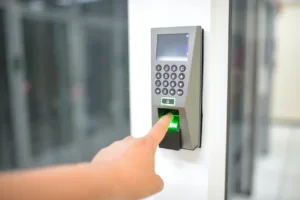The Rise of Biometric Technology in Security
In the ever-evolving world of technology, the need for robust security measures has become increasingly important. Traditional methods of authentication, such as passwords and PINs, are no longer sufficient to protect sensitive information and secure physical spaces. This has led to the rise of biometric technology, which offers a more secure and convenient way to verify identity.
Biometric technology uses unique physical or behavioral characteristics to identify individuals. These characteristics can include fingerprints, iris patterns, facial features, voice patterns, and even DNA. By using biometric data, security systems can accurately and reliably authenticate individuals, ensuring that only authorized personnel have access to restricted areas or sensitive information.

The Advantages of Biometric Security
There are several advantages to using biometric technology in security systems. First and foremost, biometric data is unique to each individual, making it extremely difficult to forge or replicate. This significantly reduces the risk of unauthorized access and identity theft.
Biometric authentication is also highly convenient. Unlike passwords or PINs, which can be forgotten or stolen, biometric data is always with the individual. This eliminates the need to remember complex passwords or carry around access cards, making the authentication process seamless and user-friendly.
Furthermore, biometric technology provides real-time authentication. With traditional methods, there is always a delay between entering the password or PIN and gaining access. Biometric systems, on the other hand, can quickly and accurately verify identity, allowing for faster and more efficient security checks.

Applications of Biometric Technology
Biometric technology has found its way into various sectors and industries, revolutionizing the way security is implemented. One of the most common applications is in access control systems. Companies and organizations use biometric authentication to secure their premises, ensuring that only authorized personnel can enter restricted areas.
Biometric technology is also being used in mobile devices, such as smartphones and tablets. Many modern smartphones now feature fingerprint scanners, allowing users to unlock their devices and authorize payments with a simple touch of their finger.
In addition to physical security, biometric technology is also being used in digital security. Many online platforms and services now offer biometric authentication as an added layer of security. This can include using facial recognition to unlock banking apps or voice recognition to authorize transactions.
The Future of Biometric Security
In the relentless march of technological progress, the evolution of biometric security stands as a testament to the constant pursuit of enhanced safety measures. As we peer into the future, the landscape of biometric security unfolds with even more thrilling prospects. One notable avenue of progress within this realm is the integration of biometric wearables—innovative devices like smartwatches or fitness trackers that extend beyond traditional security measures.
These biometric wearables are poised to redefine how we authenticate individuals. Imagine a world where your smartwatch not only tracks your steps and monitors your heart rate but also serves as a personalized key to access secured spaces or devices. The unique biometric identifiers embedded within these wearables, whether it be fingerprint recognition, heart rate patterns, or even vein recognition, could revolutionize the way we interact with our surroundings, seamlessly blending technology with personal security.
Moreover, the synergy between artificial intelligence (AI) and biometric technology represents another frontier of advancement. The marriage of these two domains opens up new horizons for security systems. Artificial intelligence, with its ability to learn and adapt, can significantly elevate the accuracy and reliability of biometric authentication processes. It brings a level of sophistication to biometric systems that not only recognizes static identifiers like fingerprints or facial features but evolves in its understanding, adapting to changes and variations over time.
In this symbiotic relationship, AI augments the capabilities of biometric systems, making them not just more secure but also highly efficient. Machine learning algorithms can discern subtle nuances in biometric data, distinguishing between authentic access attempts and potential security threats with unprecedented precision. The result is a dynamic and responsive security infrastructure that evolves with the individual it seeks to protect.
As biometric security continues to evolve, the integration of wearables and the infusion of artificial intelligence promise to usher in an era where personal identification is not only foolproof but also seamlessly integrated into our daily lives. These advancements not only bolster security measures but also offer a glimpse into a future where the interface between humans and technology becomes increasingly intuitive and sophisticated. The journey ahead holds exciting possibilities for a world where the very fabric of security is woven with the threads of innovation and intelligence.
Conclusion
Biometric technology is revolutionizing the way security is implemented. Its unique ability to accurately and reliably authenticate individuals makes it a valuable tool in protecting sensitive information and securing physical spaces. As technology continues to advance, biometric security will only become more prevalent, offering a safer and more convenient way to verify identity.